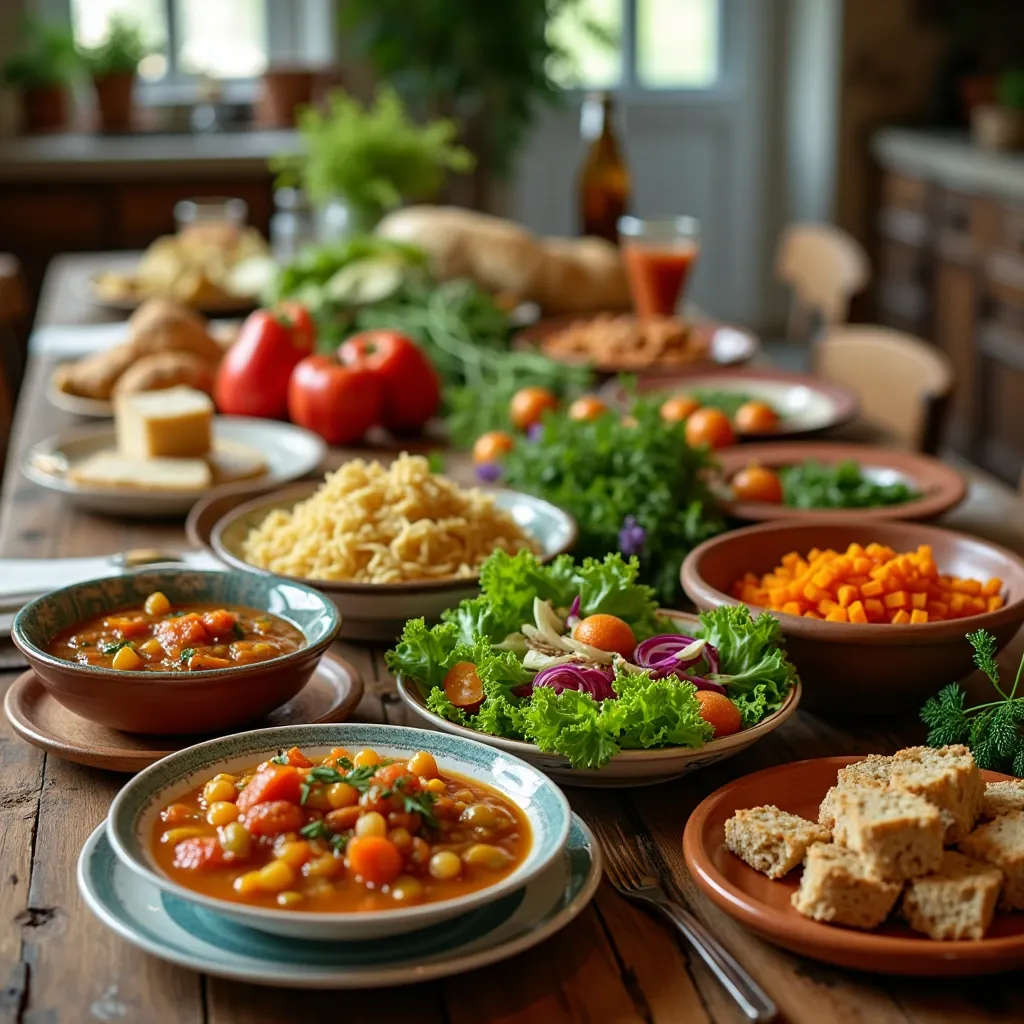The Seventh-day Adventist diet focuses on health and longevity by emphasizing plant-based foods, with an emphasis on whole grains, fruits, vegetables, nuts, and legumes. This article will explore the health benefits, popular recipes, and essential cooking techniques associated with the Adventist diet. From classic vegetarian dishes to creative global recipes, this guide will help you incorporate nutritious meals into your everyday life.

What Makes Adventist Recipes Unique?
Adventist recipes stand out for their emphasis on plant-based meals, whole foods, and a lifestyle that prioritizes health and wellness. Many Seventh-day Adventists believe in maintaining a diet that supports longevity, with minimal processed foods, no meat, and an avoidance of alcohol and caffeine. This approach to cooking emphasizes meals that are naturally low in fat, rich in fiber, and high in essential vitamins and minerals.
The focus on vegetarian recipes is based on the health benefits these diets provide. Studies, like those from the Adventist Health Study, have shown that those who follow a plant-based diet can experience a lower risk of chronic diseases such as heart disease, diabetes, and certain cancers. For more details on the impact of this diet on health, explore this health study on plant-based diets.
Health Benefits of Adventist Recipes
Adventist recipes are designed to be nutritious, easy to prepare, and beneficial to your overall health. A plant-based diet like the one followed by many Seventh-day Adventists is associated with numerous health benefits, including:
- Lower risk of heart disease: A plant-based diet helps lower cholesterol and blood pressure, reducing the risk of cardiovascular diseases.
- Weight management: Adventist recipes often include high-fiber foods, which help with satiety and weight loss.
- Improved gut health: The emphasis on fruits, vegetables, and legumes supports a healthy digestive system by providing beneficial fiber.
- Reduced cancer risk: Studies suggest that a plant-based diet can lower the chances of developing certain types of cancer.
Eating plant-based does not mean sacrificing flavor. Adventist recipes offer a wide variety of delicious dishes that are nutrient-dense and easy to make. For inspiration, check out this guide to plant-based eating.
Popular Adventist Recipes
Adventist cuisine offers a wide range of vegetarian and vegan dishes, ideal for anyone looking to adopt a healthier lifestyle. Below are some popular recipe ideas that showcase the simplicity, flavor, and versatility of the Adventist diet.
Vegetarian and Vegan Adventist Recipe Ideas
Many Adventist recipes are entirely plant-based, using whole foods that are naturally low in fat and high in essential nutrients. Below are some key ingredients and ideas commonly used in Adventist recipes:
- Legumes: Lentils, chickpeas, and beans are staple ingredients in Adventist recipes. They provide a rich source of protein and fiber.
- Whole grains: Brown rice, quinoa, and whole wheat pasta are commonly used to provide complex carbohydrates.
- Vegetables: Leafy greens, cruciferous vegetables, and root vegetables are a foundation of Adventist meals.
- Nuts and seeds: Walnuts, almonds, and chia seeds provide healthy fats and protein.
Example Recipes:
- Lentil soup: A hearty and warming dish made with lentils, tomatoes, and a variety of vegetables.
- Chickpea curry: A flavorful curry made with chickpeas, tomatoes, and coconut milk.
- Stuffed bell peppers: Bell peppers filled with quinoa, black beans, and veggies, served with a tangy avocado dressing.
These recipes highlight the versatility of plant-based ingredients, making it easy to enjoy a nutritious meal without sacrificing flavor.
Adventist Potluck Recipes
One of the most cherished traditions in the Adventist community is the potluck. These communal meals are typically held after Sabbath services and feature a variety of dishes that reflect the principles of health and wellness. Some classic Adventist potluck recipes include:
- Baked beans: A delicious, hearty dish made from beans, vegetables, and a savory sauce.
- Vegetable casseroles: A combination of grains, vegetables, and legumes baked into a savory dish.
- Vegan chili: A spicy, tomato-based chili made with kidney beans, black beans, and vegetables.
These potluck meals are perfect for sharing with others and are packed with nutrient-dense ingredients.
Adventist Breakfast Recipes
Breakfast is an important meal in any diet, and Adventist recipes provide many healthy options to start your day right. The key is to focus on whole grains, fruits, and plant-based proteins. Some popular Adventist breakfast recipes include:
- Oatmeal with fruit and nuts: A warm, satisfying breakfast that provides fiber and healthy fats.
- Smoothie bowls: Blended fruits, almond milk, and chia seeds topped with granola and berries.
- Whole-grain pancakes: Made with whole wheat flour and served with pure maple syrup or fresh fruit.
These dishes are perfect for providing lasting energy throughout the day.
Adventist Desserts and Snacks

Adventist desserts offer a healthier twist on traditional sweet treats, focusing on natural sweeteners like fruit and maple syrup instead of refined sugar. Here are some delicious Adventist dessert ideas:
- Fruit-based pies: Pies made with fresh fruit, almond flour crust, and natural sweeteners.
- Energy bars: A combination of nuts, seeds, and dried fruits for a satisfying, healthy snack.
- Raw chocolate truffles: Made with dates, cocoa powder, and coconut oil, these truffles are rich and indulgent.
These desserts offer a guilt-free way to satisfy your sweet tooth while maintaining your commitment to health.
Adventist International Recipes
Adventist communities around the world have embraced the health benefits of plant-based eating, leading to a variety of global dishes. Some examples include:
- Cuban black beans: A flavorful dish made with black beans, onions, garlic, and bay leaves.
- Indian-inspired vegetable curry: A fragrant curry made with cauliflower, peas, and potatoes, spiced with cumin, turmeric, and garam masala.
These international dishes provide a fresh perspective on Adventist cuisine and showcase the global influence of plant-based diets.
Cooking Tips and Techniques for Adventist Recipes
To make the most of Adventist recipes, it’s essential to adopt some healthy cooking techniques and meal planning tips. Here are some ways to make your Adventist meals more delicious and easy to prepare.
Meal Planning for Adventist Diets
Effective meal planning is key to maintaining a healthy diet. Adventist meal plans should emphasize fresh, seasonal ingredients and minimize processed foods. Here are some tips to get started:
- Batch cook: Prepare large quantities of meals in advance, such as soups and stews, which can be stored and eaten throughout the week.
- Embrace seasonal produce: Choose fruits and vegetables that are in season for better flavor and affordability.
- Pre-chop veggies: Keep pre-cut vegetables on hand to make meal preparation quicker and easier.
Adventist Cooking Methods
Adventist cooking often focuses on methods that retain the nutritional value of foods while reducing the need for added fats and oils. Common cooking techniques include:
- Steaming: This method helps retain the nutrients in vegetables and grains.
- Baking: Ideal for making casseroles, roasted vegetables, and plant-based breads.
- Slow cooking: Perfect for preparing hearty soups, stews, and beans, allowing flavors to develop over time.
By using these methods, you can make Adventist recipes that are both nutritious and flavorful.
Making Adventist Recipes Kid-Friendly
It can be challenging to introduce plant-based meals to young children, but there are plenty of ways to make Adventist recipes appealing to picky eaters:
- Sneak in vegetables: Add finely chopped veggies to soups, casseroles, and even smoothies.
- Make food fun: Use cookie cutters to shape sandwiches, pancakes, and veggie fritters into fun shapes.
- Offer variety: Allow kids to help prepare meals and choose their favorite fruits and veggies.
These tips can help make Adventist meals more exciting for children while promoting healthy eating habits.
FAQs
1. What do Adventists eat for dinner?
Adventists typically enjoy plant-based meals for dinner, including a variety of vegetarian and vegan dishes. Common options include lentil soups, vegetable casseroles, stir-fries with tofu, grain bowls, and bean-based stews. These meals are nutritious, low in fat, and rich in fiber, aligning with their focus on healthy eating and whole foods.
2. What to bring to a Seventh-Day Adventist potluck?
When attending a Seventh-Day Adventist potluck, it’s common to bring dishes that align with their plant-based dietary preferences. Consider bringing vegetable casseroles, salads, lentil dishes, quinoa-based salads, or vegetarian chili. Desserts like fruit-based pies or energy bars are also popular choices. Always aim for dishes that are free from meat, dairy, and processed foods.
3. What foods do Seventh-Day Adventists not eat?
Seventh-Day Adventists typically avoid meat, alcohol, caffeine, and processed foods. Their diet is plant-based, focusing on whole grains, fruits, vegetables, legumes, and nuts. Many Adventists also avoid foods like pork, shellfish, and high-fat dairy products, in keeping with their belief in maintaining a healthy, natural diet.
4. What food is taboo for Seventh-Day Adventists?
Foods that are generally considered taboo for Seventh-Day Adventists include meat (especially pork and shellfish), alcohol, caffeine, and highly processed foods. The diet encourages a focus on whole, unprocessed plant-based foods like vegetables, legumes, grains, and fruits to support overall health and well-being.
Conclusion
Adventist recipes provide a flavorful, healthy, and sustainable way to eat. Whether you’re exploring vegetarian options for the first time or looking for more plant-based meal ideas, Adventist cooking offers plenty of delicious and nutritious dishes. By incorporating these recipes into your meal planning, you’ll be taking a step toward better health, all while enjoying satisfying and wholesome meals.

